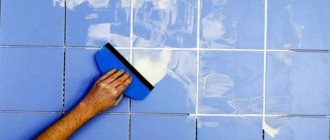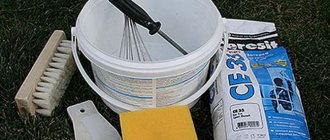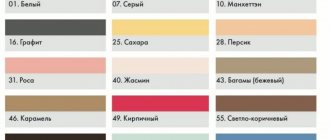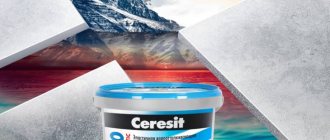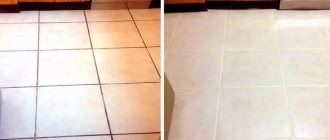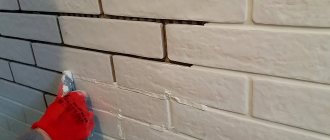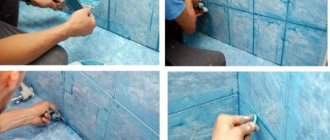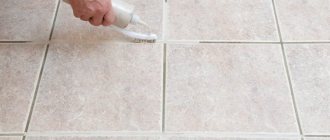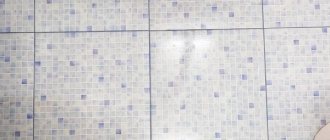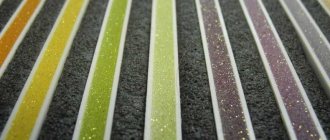Ceresit CE 40 Aquastatic grout is intended for joints up to 10 mm wide. It is water and frost resistant. Can be used for grouting joints in a bathhouse after laying tiles along with such grouts as Ceresit CE 33 Super and Ceresit CE 35 Super.
CE 40 Aquastatic - elastic water-repellent grout for joints up to 10 mm
Properties
- Available in 30 colors, including white;
- has an enhanced antifungal effect (Trio Protection “Micro Protect” formula);
- water-repellent (Aquastatic effect);
- resistant to dirt, easy to clean;
- elastic, resistant to deformation;
- has high color fastness;
- perfectly smooth;
- water- and frost-resistant;
- can be used on heated floors;
- suitable for indoor and outdoor use;
- environmentally friendly.
Application area
Grout CE 40 Aquastatic is intended for filling joints of ceramic, stone (including marble) and glass cladding on floors and walls inside and outside buildings, with a joint width of up to 10 mm. Due to its high elasticity, the grout can be used on deformable substrates (chipboards, particle boards, plasterboard, etc.) and substrates subject to temperature fluctuations (heated floors, terraces, outdoor swimming pool baths, etc.).
Thanks to the “Aquastatic” effect (hydrophobic properties) and the “MicroProtect” formula (high resistance to fungus and mold), CE 40 grout is optimal for use in rooms with constant humidity: bathrooms, showers, kitchens, etc.
It is recommended to fill corner, expansion joints and joints adjacent to sanitary equipment with silicone grout CS 25.
Comparative table of grout consumption rates from different manufacturers, kg/m2
The grout consumption table for tiles looks like this:
| Length, width and thickness of tiles (centimeters) | Grout brand | Approximate grout consumption rate (kg per meter2) |
| 10 x 10 x 0.6 | Ceresit | 0,21 |
| Litokol | 0,19 | |
| Mapel | 0,18 | |
| 20 x 20 x 0.8 | Ceresit | 0,14 |
| Litokol | 0,12 | |
| Mapel | 0,13 | |
| 30 x 30 x 0.6 | Ceresit | 0,07 |
| Litokol | 0,06 | |
| Mapel | 0,07 | |
| 40 x 40 x 0.8 | Ceresit | 0,07 |
| Litokol | 0,06 | |
| Mapel | 0,07 | |
| 60 x 60 x 1 | Ceresit | 0,06 |
| Litokol | 0,05 | |
| Mapel | 0,06 |
Please note that the table shows grout consumption rates for sealing a 1 mm thick seam . If you are dealing with a thicker seam, then you need to multiply the corresponding number from the table by the thickness value.
For example, you want to seal a 3 millimeter thick seam using a Ceresit mixture, where the tile parameters are 20 x 20 x 0.8 centimeters.
The tile grout consumption table states that the consumption rate in this case is 0.14 kg. Since the layer thickness is 3 millimeters, you need to multiply 0.14 by 3, which will be equal to 0.52. That is, the grout consumption in this case will be 0.52 kg per square meter of wall.
Preparing the base
Filling the joints of the tile cladding should only be done after the period specified in the instructions for the adhesive used has expired. If a traditional cement-sand mixture was used to attach the tiles, filling the joints can be done no earlier than 7 days after laying the tiles.
The base and tile adhesive must be dry. The edges of the seams must be cleaned of tile adhesive, as well as dust, grease and other contaminants that interfere with the adhesion of the grout. It is recommended to moisten the edges of the tiles with a damp sponge. When grouting existing tiles, the old grout should be completely removed.
In the case of matte, unglazed or stone tiles, it is necessary to test the coloring of the tiles with pigments contained in the grout.
Grout consumption for tile joints per 1m2 - cost standards
During installation, a small gap is left between the tiles. Typically it is 2-3 millimeters for walls, or 3-4 millimeters for floors. To prevent dirt from entering, it is necessary to seal these gaps and seams using special mixtures based on cement or epoxy resin.
Today there are many grout mixtures on the market, and the main manufacturers are Ceresit, Litokol, and Mapel. The consumption of these materials depends on:
- material density - the smaller the grain size of the material, the less grout consumption will be;
- size of ceramic tiles - the smaller the tile, the longer the length of the grout joint. In this sense, large tiles are more economical in terms of grout consumption;
- seam width and depth.
Calculation formula
To calculate the grout consumption for tiles per square, use the following formula:
R = ((DP + ShP) / (DP x ShP)) x ShSh x GSh x KPS
Where:
- DP and ШП are the length and width of the tile. Units of measurement are millimeters.
- ShSh and GSh are the width and depth of the seam. Units of measurement are millimeters. Please note that in most cases the joint depth (GD) coincides with the thickness of the tile. If the tiles were laid on a thick layer of cement, you need to add 1-2 millimeters to take into account the thickness of the installation layer.
- KPS is the grout density coefficient. Cement grouts usually have a coefficient of 1.7-2.1 units. Epoxy mixtures are less dense - for them the coefficient is usually 1.4-1.7 units.
Please note that if you apply the formula, you will receive grout expressed in grams. To get kilograms, you need to divide the resulting number by 1000.
Execution of work
To prepare the mixture, take a measured amount of clean water at a temperature of +15 to +20°C. The dry mixture is gradually added to the water while stirring, achieving a homogeneous mass without lumps. Mixing must be done with a mixer or drill with an attachment at a rotation speed of 400-800 rpm. Then a technological pause is maintained for about 5 minutes to allow the mixture to mature and mix again. The mixture, ready for use, must be consumed within 2 hours from the moment of preparation . An overdose of water leads to a deterioration in the technical characteristics of the grout!
The joints are filled with grout using a rubber spatula, collecting excess from the surface with diagonal movements. After about 15 minutes, the surface of the cladding is carefully wiped with a damp, well-wrung out, frequently rinsed sponge. Excessive moistening of the seams can lead to the appearance of different colors!
Dried plaque from the tiles is removed with a dry soft cloth no later than 8 hours after filling the joints. The technological passage is possible after 8 hours, and the first contact with water is possible after 7 days after filling the joints.
Length, width and thickness of tiles
According to overall dimensions, facing tiles are divided into:
- classic – with a side of 100-500 mm;
- small-sized - this group includes small chips (50x50 mm) used to create mosaic compositions;
- large-sized - with a side from 500 to 1200 mm.
Applying grout
Wall decoration, in most cases, is made with rectangular tiles with dimensions of 200x250 or 200x300 mm. But products with sides of 120x240, 150x200 and 150x150 mm are also often used.
The dimensions of the tiles are chosen to be a multiple of the dimensions of the surface to be finished. This method will reduce the amount of waste and reduce the labor intensity of cladding.
Recommendations
- Work should be carried out at air and base temperatures from +5 to +30°C and relative air humidity not higher than 80%.
- Increased humidity of the base, different amounts of mixing water, uneven drying and too intensive smoothing of the seams can lead to the appearance of different colors. To avoid differences in the shades of the joints, it is recommended to use grout from the same batch on the same plane.
- When working, you should use tools made of stainless materials.
- Within 24 hours after filling the joints, the grout must be protected from drying out (protect from direct sunlight, wind, heat, etc.), and within 7 days - from contact with water (for external work, provide protection from rain).
How to choose the right Ceresit grout color
40 and 33 mixtures have a large palette of shades, including unusual options that can be matched to different types of tiles.
Usually the shade is selected to match
Even if it is a little darker or lighter, it doesn’t matter. In some finishing options, playing with contrasts is acceptable, this is especially true when finishing with mosaics. If you are using bright tiles with an expressive print, it is wise to limit yourself to a transparent grout that will not distract from the main design.
The color of the mixture can be selected online on the manufacturer’s website. You simply indicate the color of your tile and choose from several suggested options the one you like best.
Remember that when it dries, after a couple of days, the shade will lighten.
Specifications
Technical characteristics of Ceresit CE 40 Aquastatic adhesive
Approximate consumption of dry mixture CE 40 Aquastatic depending on the width of the joint and the size of the tile:
Approximate consumption of dry mixture CE 40 Aquastatic depending on the width of the joint and the size of the tile
Reviews
- Alena Kazachenko, 23 years old: “I decided to try something new in life and do some cosmetic renovations in the apartment myself. The bathroom had to be re-grouted and grouted. I scoured the Internet in search of a suitable product and chose Ceresit CE 40. Everything turned out to be simpler than I thought! I did everything according to the instructions, plus watched a couple of videos. The grout went on easily and even somehow refreshed the tiles.”
- Yuri Maksimov, 45 years old: “I was doing renovations in my daughter’s apartment, when it was the turn of the bathroom, I spent a long time choosing tiles and grout for it. In the end, I settled on Ceresit CE 40 and did not regret it: the manufacturer did not lie when it advertised the grout as elastic and moisture-resistant. Over the course of a year, the seams have not faded or crumbled.”
- Vladimir Kosyrev, 37 years old: “I use Ceresit CE 40 to fill joints in facades, bathrooms, bathhouses. It fits everywhere as it should and does not crack over time. The color is uniform, if you choose the tone to match the tile, you won’t even notice it. I recommend."
Grout "Ceresit" CE 40 will help protect the tile structure from destruction and significantly increase its durability. You just need to follow the operating instructions and choose trusted stores.
Color range CE 40 Aquastatic
Color range CE 40 Aquastatic (click to enlarge)
The product contains cement and when interacting with water gives an alkaline reaction, therefore it is necessary to protect your eyes and skin when working with it. If the mixture gets into your eyes, rinse them with water and seek medical help.
All stated quality indicators and recommendations are valid for an ambient temperature of +20°C and a relative air humidity of 60%. In other conditions, the technical characteristics of the material may differ from those indicated.
In addition to the technical description, when working with the material, you should be guided by the relevant building codes and regulations of the Russian Federation. The manufacturer is not responsible for non-compliance with technology when working with the material, as well as for its use for purposes and conditions not provided for in this technical description. If you are in doubt about the suitability of a particular material, you should test it yourself or consult the manufacturer. The technical description, as well as recommendations not confirmed in writing, cannot serve as a basis for the unconditional liability of the manufacturer. With the appearance of this technical description, all previous ones become invalid.
